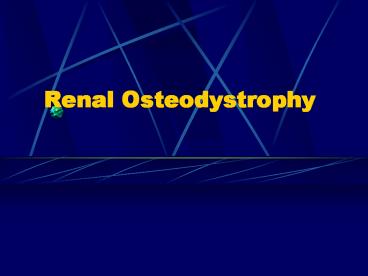Renal Osteodystrophy PowerPoint PPT Presentation
1 / 22
Title: Renal Osteodystrophy
1
Renal Osteodystrophy
2
- Skeletal disorders that primarily occur in
patients with renal failure - Osteitis fibrosa
- Osteomalacia
- Adynamic bone lesions
- Mixed lesions
- Dialysis related amyloidosis
3
Osteitis fibrosa and secondary hyperparathyrodism
- High level of PTH, increase number and activity
of osteoblasts and osteoclasts - High bone turnover
- Increased quantity of unmineralized bone matrix(
osteoid)
4
(No Transcript)
5
Pathogenesis of secondary hyperparathyrodism(1)
- Phosphate retention and Calcitriol deficiency
- GFR less than 20 of normal ,hyperphosphatemia
develops - Limited amount of residual renal mass available
for Calcitriol synthesis - Calcium malabsorption
- Calcitriol deficiency leads to impaired GI
absorption of calcium, as GFR falls below 50 ml
/min
6
Pathogenesis of secondary hyperparathyrodism(2)
- Skeletal resistance to Calcemic action of PTH
- Decreased number of Calcitriol receptors in the
uremic parathyroid gland - Calcitriol reduces prepro-PTH messenger RNA
levels by decreasing the rate of gene
transcription - Parathyroid hyperplasia
- Little is known about the factors that lead to
cellular proliferation - Once established ,not reversed by short term
calcitriol treatment
7
Diagnosis of uremic hyperparathyrodism
- High level of I-PTH. Without liver disease, serum
Alk-P level often correlate with PTH - Radiographic changes of osteitis fibrosa
- Subperiosteal erosions of phalanges
- Erosions at proximal end of the tibia ,neck of
femur or humerus and inferior surface of distal
end of clavicle - In the skull, salt and pepper appearance
- Bone biopsy necessary when diagnosis uncertain
8
Prevention and treatment of uremic
hyperparathyrodism
- Phosphorus control
- In early renal failure, phosphorus accumulation
may be avoided by restriction of dietary
phosphorus intake to 600-800mg/d - Limiting meats and dairy products
- More strict dietary phosphorus restriction is
usually impractical
9
- Phosphorus control
- Phosphorus binder
- Containing aluminum
- Calcium carbonate
- Calcium acetate
- not containing calcium or aluminum ,
sevelamer hydrochloride - As patients begin dialysis therapy, increase
dietary phosphorus to 800-1200 mg/d - Hemodialysis removes approximately 1000mg
/treatment - CAPD removes 300 mg/d
10
Prevention and treatment of uremic
hyperparathyrodism
- Control of calcium
- Use of vitamin D sterols
- Metabolite of vitamin D directly suppressing PTH
secretion, marked suppression of PTH - administering 1-2 ug of calcitriol intravenously
after each hemodialysis three times a week - Pulse oral calcitriol 2-4 ug twice a week
- If PTH levels do not fall into an acceptable
range after 1 year of treatment ,surgical
parathyroidectomy or parathyroid gland ablation
by ethanol should be considered
11
- Use of vitamin D sterols
- Calcitriol should not be used
- when hyperphosphatemia is present
- Calcium-phosphorus product of greater than 75 may
lead to soft tissue calcifications - Paricalcitol and doxercalciferol , analogs of
calcitriol ,less active in raising calcium and
phosphorus level were approved in United States - If PTH less than 250 pg/ml( or less than four
times the upper limits of normal) - Inducing adynamic bone lesions
12
- Use of vitamin D sterols
- Vitamin D induced hypercalcemia is particularly
prolonged and may require weeks for resolution
13
Osteomalacia
- Pathogenesis
- Metabolic acidosis
- Aluminum intoxication ,directly suppresses PTH
secretion - Contamination of dialysate
- phosphorus binders containing aluminum
- Citrate increases absorption of aluminum from the
gut
14
Osteomalacia
- Diagnosis
- Low PTH level
- Exposure to aluminum
- Bone and muscle pain ,spontaneous fractures occur
in approximately 15 - Radiographic findings are not distinctive
- DFO test
- Gold standard is bone biopsy
15
- Diagnosis
- DFO test
- 5-20 mg/kg administered intravenously at the end
of dialysis - Serum aluminum measured 24 to 48 hrs later
- Basal serum aluminum level of gt100 ug/L and an
increment in aluminum level of gt150 ug/L
following chelation with DFO
16
- Prevention and treatment of osteomalacia caused
by aluminum - Dialysate purified
- Avoidance of phosphorus binders containing
aluminum - Chronic chelation therapy with DFO
- Risk of mucormycosis infections occurs in up to
5 of treated patients - Acute encephalopathy has been described with DFO
- Binds iron
- DFO should be restricted to those who have severe
symptoms of aluminum intoxication and
histological evidence of aluminum accumulation in
the bone
17
Adynamic bone lesions
- Decreased bone mineralization ,with normal
amounts of osteoid - 50 of cases ,cause if aluminum deposition
.Little is known about the etiology in the
remaining - Common in patients treated with PD ,in the
elderly and patients with DM - Fewer symptoms of bone pain, myopathy and
fractures than osteomalacia and osteitis fibrosa
18
Mixed lesions
- Histological evidence of both osteitis fibrosa
and osteomalacia - High PTH level
- Previously established osteodystrophy who
developing a aluminum-related bone disease - Treatment is withdrawal of aluminum exposure and
aggressive treatment of the hyperparathyrodism
19
Dialysis-related Amyloidosis
- Bone cysts ,pathological fracture ,arthritis ,and
carpal tunnel syndrome treated with long term
dialysis - Deposition of ß 2-microglobulin
- No proven treatment for the amyloidosis
arthropathy - Use of high flux hemodialysis or
hemodiafiltration removes some ß 2-microglobulin - Early renal transplantation completely prevents
the disease
20
(No Transcript)
21
Renal osteodystrophy following renal
transplantation
- Mild to moderately severe osteitis fibrosa
resolve within a year - Severe hyperparathyrodism may not completely
resolved ,and elevated PTH levels may persisted
for 5-10 years - Symptoms of amyloid deposition often improve, but
radiographic findings do not change .This
suggests that amyloid may be irreversibly bound
to soft tissue
22
Overall approach to the management of renal
osteodystrophy
- Target calcium and phosphorus levels are 9.5-10.5
and 4.5-5.5 mg/dL - At time of surgery ,all four glands should be
identified - Some surgeons will do a three and one half gland
parathroidectomy others will remove all glands
and implant small pieces of one gland into the
forearm - recurrence rates are the same for the two
techniques 5-15

